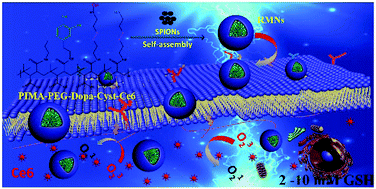Polymer ligand-assisted fabrication of multifunctional and redox-responsive self-assembled magnetic nanoclusters for bimodal imaging and cancer treatment†
Abstract
Multifunctional nanoplatforms that can combine diagnostic functions and therapeutic capabilities are highly required for the construction of novel cancer diagnosis-therapy integrative systems. In this work, we developed multifunctional and tumor redox-responsive magnetic nanoclusters (RMNs) by the self-assembly of iron oxide nanoparticles with a chlorin e6 (Ce6)-disulfide-linked polymer ligand. The core of RMNs could enhance the T2-weighted MR contrast capability, and the surface ligand could improve the system stability and load Ce6. In addition, the obtained RMNs also exhibited excellent biocompatibility and higher cytotoxicity upon near infrared (NIR)-irradiation. These RMNs with a size of ∼90 nm can effectively facilitate their accumulation in tumor sites through the enhanced permeability and retention (EPR) effect and subsequently are endocytosed into a highly reductive intracellular environment that activates fluorescence and photodynamic therapeutic antitumor activity. Furthermore, the in vivo imaging and therapy results not only confirmed that RMNs can as bimodal imaging probes for the early-stage diagnosis of cancer but also demonstrated the superior photodynamic therapeutic efficiency of RMNs in suppressing tumor growth. These results indicated that RMNs show great potential for simultaneous diagnostic imaging and photodynamic therapy.



 Please wait while we load your content...
Please wait while we load your content...